June marked the 25th Anniversary of Gramercy! Thank you to our valued investors, trusted business partners and team members without whom this milestone could not have been reached. We are excited for the opportunities we see ahead, and look forward to continuing to deliver upon our mission to have a positive impact on the well-being of our clients, portfolio investments (and their communities) and our team members.
Contents
Market Overview
Macro Review
U.S. inflation fell, which re-priced global risk markets. Headline inflation in the U.S. fell to 3%, which is the lowest since March 2021. This was mostly driven by the fall in airfares (-18.9%) and used car prices (-5.2%), which closely tracked the Manheim index data from Tuesday (-4.2%), reflecting its largest decline since April 2020. Earlier in the week, China recorded inflation at 0.0% with PPI deeply in the negative territory as trade data weakened considerably. China’s export data (-12.4%) was the worst monthly recording since February 2020 and confirmed the hunch of weakening global demand, just as imports remained fragile and in contraction. Back to the U.S., the narrative softened for future rate hikes, but July still remains a “done deal”. The message is instead consistent with higher for longer, but perhaps “one and done” as the Fed re-assesses future data points. The more hawkish Fed officials sought to reiterate a second hike, although the messaging could be softened with the St. Louis Federal Reserve President resignation. This is at odds with the Bank of England and ECB who are expected to deliver several further hikes this year. Instead, it is possible that the Fed are put into the same camp as the Reserve Bank of New Zealand, who paused the tightening cycle this month. Note that the Bank of Canada surprised markets again with a 25 bps hike as they did in June, having previously paused the tightening cycle since January. Meanwhile, the Bank of Korea reflected what most Asian central banks (excluding China) are doing by keeping policy rates unchanged and instead looking for an opportunity to cut once inflation is firmly within the target band (i.e. like Indonesia). With signs that most central banks have paused the tightening cycles, and the Fed is left in a “one and done” scenario, the short USD narrative will become more entrenched. The early signs have seen U.S. Treasuries rally, CHF rose to its strongest level since 2015, EMFX benefitted (especially ZAR) and the S&P and Nasdaq rose to a 15-month high. The theme extended to U.S. exceptionalism being unwound, EM outperforming DM given the upcoming cutting cycle with comfortable real interest rate buffers and ultimately the Fed’s policy tightening taking a significant toll on the global economy.
EM Credit Update
Emerging market sovereign credit (cash bonds) ended the week up 2.4% with spreads -9 bps tighter as U.S. Treasuries also rallied 18-37 bps. Sovereign outperformers were Ukraine, Pakistan and Tunisia, while Suriname, Tajikistan and Georgia underperformed. Pakistan was the top performer in cash price moves and therefore total return, but only rallied 393 bps in credit spread terms to Ukraine’s 518 bps. Pakistan received IMF Board Approval for the $3 billion 9-month program, which saw the immediate disbursement of $1.2 billion and reduced the probability of default ahead of the September wall of coupon payments.
The Week Ahead
Key events next week rest with U.S. retail sales and industrial production. After the softer U.S. CPI reading last week, the same data is due out of the UK and Euro-area. EM central bank decisions are due out of Turkey (15%) and Russia (7.5%). The PBoC are expected to keep the one-year MLF rate unchanged at 2.65% after cutting in June, along with the one-year and five-year LPR rates at 3.55% and 4.2%. We can also expect China’s 2Q GDP release to be closely watched as it markedly improves on 4.5% in 1Q. Meanwhile, we have already seen a number of central bank officials shuffle around, which has been more active than the English Premier League transfer window. Michelle Bullock replaced Philip Lowe as the new RBA Governor, James Bullard resigned as St. Louis Federal Reserve President and the Bank of England recently appointed Megan Greene to the MPC. Finally, Evergrande is expected to report its long-awaited 2021 and 2022 annual results on Monday, which could include further progress in relation to debt restructuring talks.
Highlights from emerging markets discussed below: NATO membership for Ukraine remains a remote possibility but long-term security guarantees by G7 could provide a medium-term solution, Pakistan receives IMF board approval on new Stand-By Agreement (SBA) and receives $1.2 billion disbursement, and Zambia obtains IMF board approval on first Extended Credit Facility (ECF) review and receives $189 million disbursement.
Fixed Income
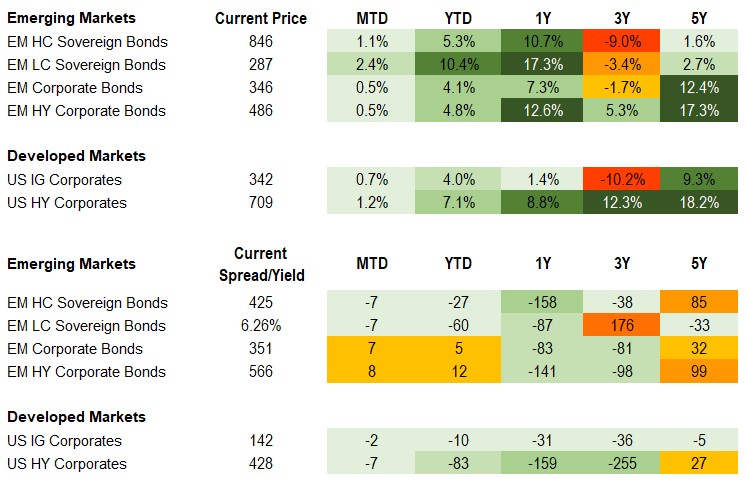
Equities
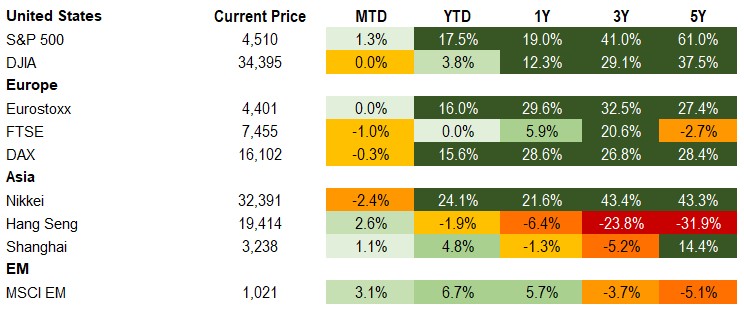
Commodities

Source for data tables: Bloomberg, JPMorgan, Gramercy. EM Fixed Income is represented by the following JPMorgan Indicies: EMBI Global, GBI-EM Global Diversified, CEMBI Broad Diversified and CEMBI Broad High Yield. DM Fixed Income is represented by the JPMorgan JULI Total Return Index and Domestic High Yield Index. Fixed Income, Equity and Commodity data is as of July 14, 2023 (mid-afternoon).
Emerging Markets Weekly Highlights
NATO membership for Ukraine remains a remote possibility but long-term security guarantees by G7 could provide a medium-term solution
Event: NATO’s Vilnius summit this week did not produce an official invitation for Kyiv to join the Alliance, which President Zelenskiy’s Administration has been hoping for. However, Ukraine received “specific, bilateral, long-term security commitments” by the major western powers as well as new pledges of military and economic support in the near-term.
Gramercy commentary: We’ve been of the view that it would be politically very challenging for NATO member-states to agree on a pathway to offering full-fledged membership to Ukraine at an acceptable geopolitical cost. As such, we are not surprised by the lack of a formal invitation that triggered President Zelenskiy’s disappointment. This being said, Ukraine received important high-profile commitments by the West, both in terms of military/economic support over the near-term and security guarantees over the long-term. The former will play a critical role in how successfully Kyiv’s ongoing counteroffensive against Russian forces develops in the coming months. The latter could serve as a viable alternative to Ukraine’s full NATO membership that we think is likely to remain a geopolitical “hot potato” for the foreseeable future. Meanwhile, western governments, multilateral organizations and private creditors continue to contemplate various measures to financially help Ukraine while the conflict persists and ease the government’s debt service burden when the time for reconstruction comes. Markets have grown more optimistic about the possibility that post-war Ukraine obtains access to funds from/generated by Russia’s government assets, which are currently frozen by the G7 jurisdiction. We believe market optimism might be a bit overdone, given significant legal complexities and security implications of such a scenario.
Pakistan receives IMF board approval on new Stand-By Agreement (SBA) and receives $1.2 billion disbursement
Event: As telegraphed, the IMF’s board approved Pakistan’s new 9-month $3 billion SBA this week, triggering a $1.2 billion disbursement. The goal of the facility is to support immediate efforts to stabilize economic conditions and guard against shocks, creating space for social and development spending. The press release notes success of the program will require greater fiscal discipline, a market determined exchange rate and reform progress. The remaining $1.8 billion will be phased over two quarterly reviews.
Gramercy commentary: The long-awaited IMF funds provide the country with much needed short-term balance of payment relief and materially lowers the near-term risk of default as reflected by the 20+ point rally in bond prices. While the IMF has reportedly attempted to secure assurances from both political parties that a commitment to the program policies will remain intact through the likely electoral period this fall and in the aftermath, uncertainty over execution and the remaining $1.8 billion of disbursements may return. As such, we acknowledge that there is room for renewed volatility despite the higher likelihood for a muddle through path to a more constructive medium-term scenario.
Zambia obtains IMF board approval on first Extended Credit Facility (ECF) review and receives $189 million disbursement
Event: The IMF board approved the delayed first review of Zambia’s existing $1.3 billion ECF this week which provides the country with a $189 million disbursement. This comes on the heels of the deal in principle reached with official creditors last month. The press release notes that the country’s performance under the program remains strong with all quantitative criteria met for the first review, with bold steps taken to strengthen fiscal sustainability and economic governance. The Fund notes timely finalization of a Memorandum of Understanding (MOU) with official creditors and private creditors is important.
Gramercy commentary: The approval was largely anticipated following last month’s news of an agreement with official creditors and reflects some degree of flexibility on the part of the Fund providing approval in absence of a signed MOU. While not explicit, many expect this may be a requirement for the second review later this year. Some speculation regarding the carve out of select Chinese creditors from the official deal could still complicate the bondholder process, but recently signed NDAs suggest that momentum towards private creditor proposals is building with prospects for a resolution before year-end or sooner.
Emerging Markets Technicals
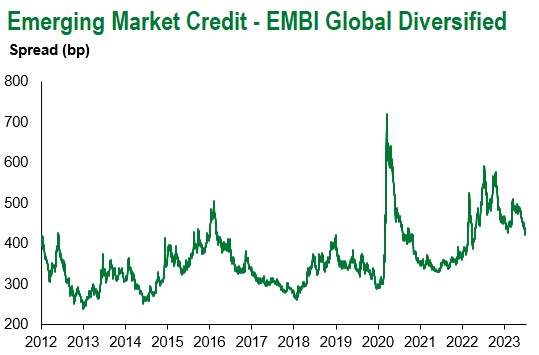
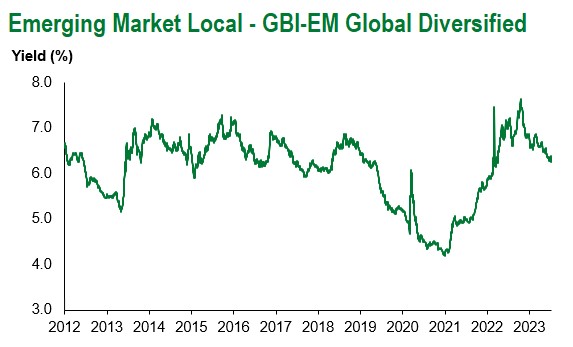
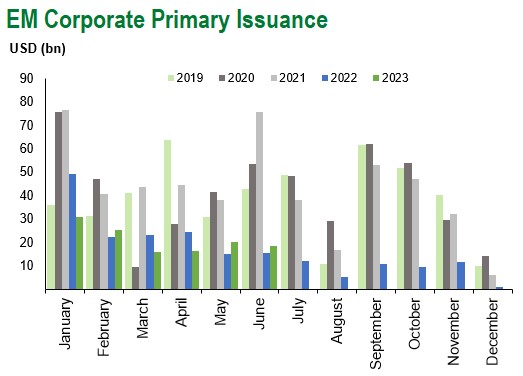
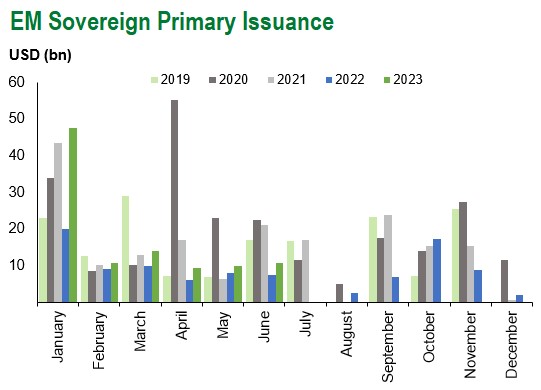
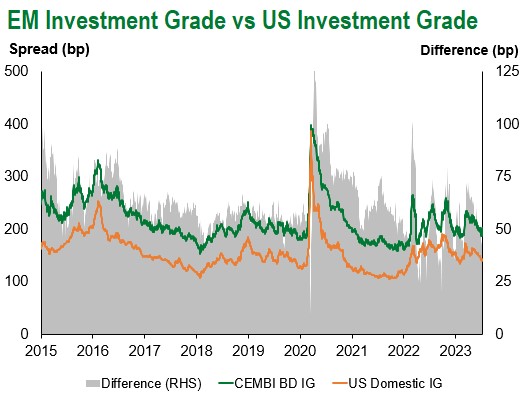
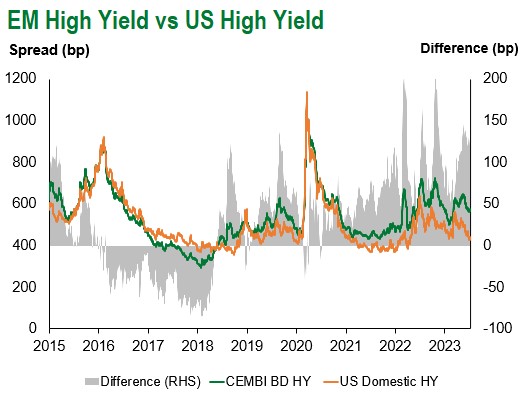
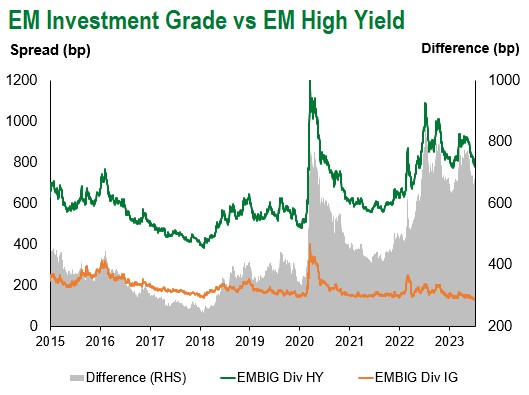
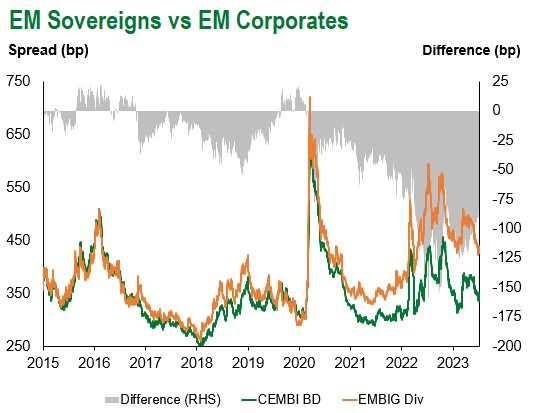
Emerging Markets Flows
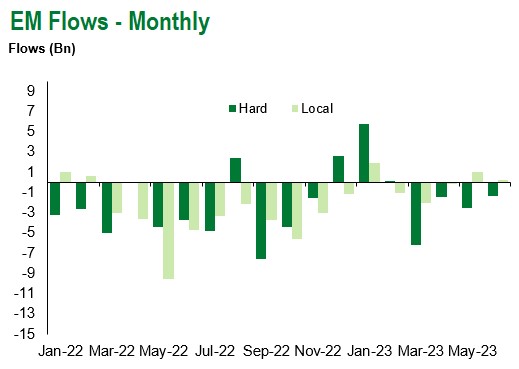
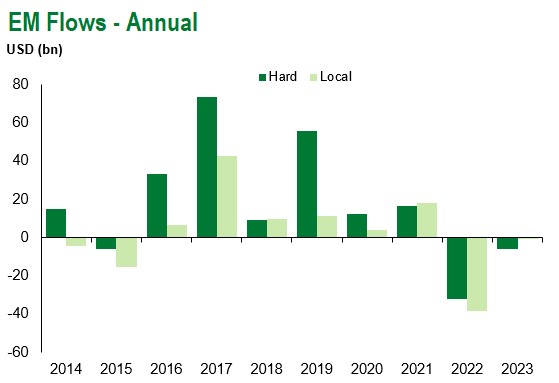
Source for graphs: Bloomberg, JPMorgan, Gramercy. As of July 14, 2023.
For questions, please contact:
Kathryn Exum, CFA ESG, Director, Co-Head of Sovereign Research, [email protected]
Petar Atanasov, Director, Co-Head of Sovereign Research, [email protected]
James Barry, Director, Deputy Portfolio Manager, [email protected]
This document is for informational purposes only. The information presented is not intended to be relied upon as a forecast, research or investment advice, and is not a recommendation, offer or solicitation to buy or sell any securities or to adopt any investment strategy. Gramercy may have current investment positions in the securities or sovereigns mentioned above. The information and opinions contained in this paper are as of the date of initial publication, derived from proprietary and nonproprietary sources deemed by Gramercy to be reliable, are not necessarily all-inclusive and are not guaranteed as to accuracy. This paper may contain “forward-looking” information that is not purely historical in nature. Such information may include, among other things, projections and forecasts. There is no guarantee that any forecasts made will come to pass. Reliance upon information in this paper is at the sole discretion of the reader. You should not rely on this presentation as the basis upon which to make an investment decision. Investment involves risk. There can be no assurance that investment objectives will be achieved. Investors must be prepared to bear the risk of a total loss of their investment. These risks are often heightened for investments in emerging/developing markets or smaller capital markets. International investing involves risks, including risks related to foreign currency, limited liquidity, less government regulation, and the possibility of substantial volatility due to adverse political, economic or other developments. References to any indices are for informational and general comparative purposes only. The performance data of various indices mentioned in this update are updated and released on a periodic basis before finalization. The performance data of various indices presented herein was current as of the date of the presentation. Please refer to data returns of the separate indices if you desire additional or updated information. Indices are unmanaged, and their performance results do not reflect the impact of fees, expenses, or taxes that may be incurred through an investment with Gramercy. Returns for indices assume dividend reinvestment. An investment cannot be made directly in an index. Accordingly, comparing results shown to those of such indices may be of limited use. The information provided herein is neither tax nor legal advice. Investors should speak to their tax professional for specific information regarding their tax situation.
